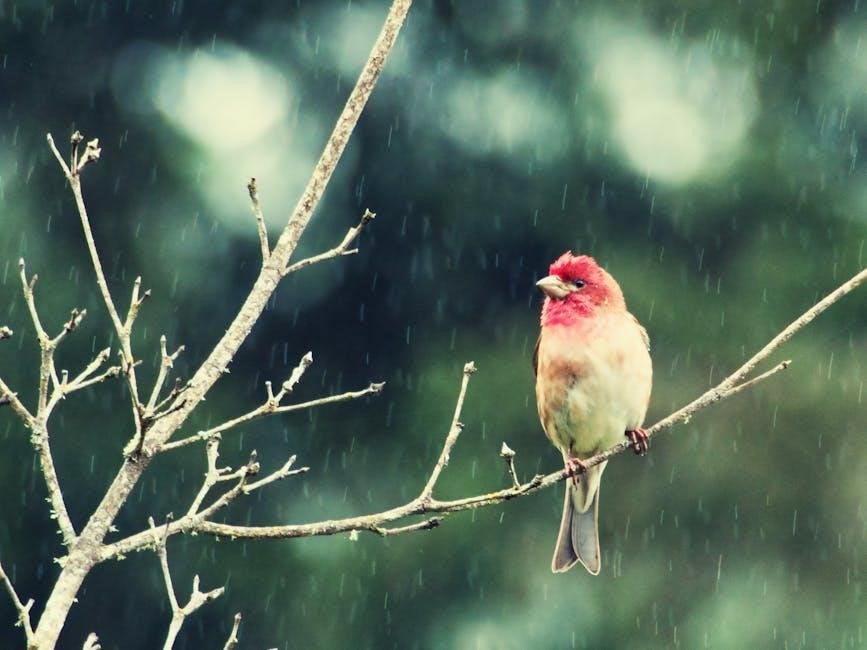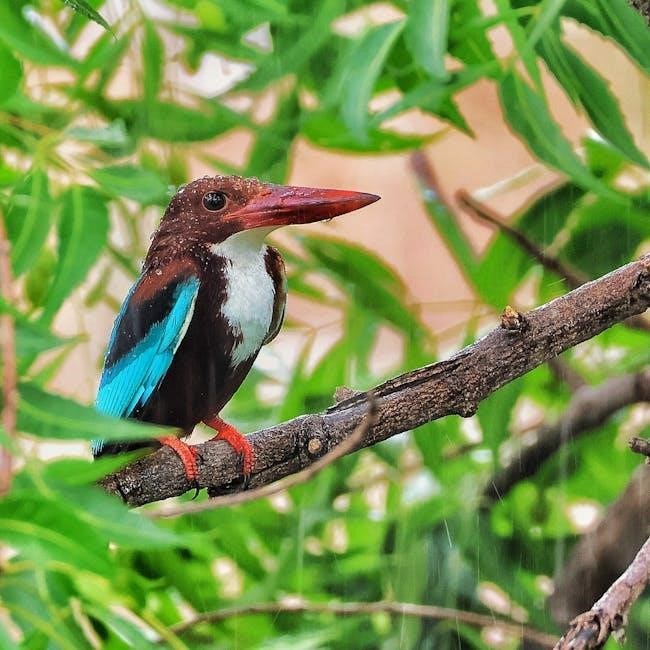Welcome to the Rain Bird Rain Sensor Manual, your guide to understanding and using this innovative device for smart irrigation solutions. This manual helps you optimize water usage by automatically shutting off irrigation during rainfall, ensuring efficiency and conservation. It provides detailed instructions for installation, calibration, and troubleshooting, making it easier to maintain your system. Discover how to adjust rainfall settings and integrate the sensor with your existing irrigation controller for seamless operation.
1.1 Overview of the Rain Bird Rain Sensor
The Rain Bird Rain Sensor is a revolutionary device designed to optimize irrigation systems by automatically shutting off sprinklers during rainfall. It ensures water conservation and prevents overwatering, promoting healthier landscapes. The sensor is easy to install and integrates seamlessly with compatible controllers. With adjustable rainfall settings, it allows customization to suit specific watering needs. Its durable design withstands various environmental conditions, making it a reliable solution for residential and commercial irrigation. By preventing unnecessary watering, it helps reduce water bills and supports eco-friendly practices. This sensor is a must-have for anyone looking to enhance their irrigation system’s efficiency and environmental performance.
1.2 Importance of Using a Rain Sensor
Using a rain sensor is crucial for optimizing water usage in irrigation systems. It prevents overwatering by automatically stopping sprinklers during rainfall, which helps conserve water and reduces utility costs. This eco-friendly solution also protects plants from waterlogged soil, promoting healthier growth. By integrating a rain sensor, you ensure that your irrigation system operates efficiently, avoiding unnecessary water waste. Additionally, it enhances compliance with local watering restrictions and supports sustainable landscaping practices. Overall, a rain sensor is an essential component for any irrigation system, offering both environmental and economic benefits that make it a valuable investment for homeowners and businesses alike.

Understanding the Rain Bird Rain Sensor
Understanding the Rain Bird Rain Sensor is key to optimal performance. It detects moisture levels, ensuring irrigation systems operate efficiently and conserve water effectively, promoting sustainability.
2.1 Key Features of the Rain Bird Rain Sensor
The Rain Bird Rain Sensor boasts several standout features, including adjustable rainfall settings from 1/8 to 3/4 inches, allowing customization to suit various weather conditions. Its wireless connectivity simplifies installation and operation, while the smart home integration enables seamless control through popular platforms. The sensor’s remote monitoring capability ensures users can track irrigation status from anywhere. Additionally, it features a normally-closed single-pole switch that interrupts the irrigation system during rain, preventing water waste. Built with durability in mind, it withstands harsh environmental conditions, making it a reliable choice for outdoor use. These features collectively enhance water conservation and system efficiency.
2.2 How the Rain Sensor Works
The Rain Bird Rain Sensor operates by detecting rainfall and automatically shutting off the irrigation system when a set threshold is reached. It uses a mechanical mechanism to measure moisture levels. As rain falls, it accumulates on the sensor, triggering a switch that interrupts the electrical connection to the irrigation controller. This prevents unnecessary watering during rainfall. The sensor’s design ensures it dries out after rain stops, allowing the system to resume normal operation. By integrating with the irrigation controller, it provides a seamless and efficient water-saving solution, adapting to weather conditions to optimize water usage and maintain lawn health. This process is both reliable and energy-efficient, ensuring optimal performance in various environmental conditions.

Installation of the Rain Bird Rain Sensor
Install the Rain Bird Rain Sensor by selecting a suitable location, wiring it to your irrigation controller, and securely mounting it. Proper installation ensures accurate rainfall detection and reliable system shutdown during rain, optimizing water conservation and system efficiency.
3.1 Choosing the Right Location for the Sensor
Selecting the correct location for your Rain Bird Rain Sensor is crucial for accurate performance. Ensure it is installed in an open area exposed to direct rainfall, avoiding shaded spots or areas obstructed by trees or structures. The sensor should be placed at a height where it can collect rain evenly, typically 3-4 feet above the ground, and away from sprinklers to prevent water interference. Proper placement ensures the sensor detects rainfall accurately, allowing your irrigation system to respond effectively, thus conserving water and maintaining landscape health. Avoid installing near gutters or downspouts to prevent water overflow interference.
3.2 Step-by-Step Installation Guide
Begin by unpacking and inspecting the Rain Bird Rain Sensor for any damage. Mount the sensor in a location with unobstructed access to rainfall, ensuring it is level and securely attached. Follow the manufacturer’s instructions to attach the sensor to the bracket. Connect the sensor to your irrigation controller, ensuring proper wiring according to the system’s specifications. Set the rainfall threshold by adjusting the dial to match your desired water conservation goals. Test the sensor by simulating rainfall to ensure it triggers the irrigation system correctly. Finally, review and save your settings to complete the installation process efficiently.
3.3 Wiring the Rain Sensor
Wiring the Rain Bird Rain Sensor involves connecting it to your irrigation controller. Ensure the system is powered off before starting. Locate the sensor terminal on the controller, typically labeled as “SEN” or “RAIN.” Connect one end of the sensor wire to this terminal and the other to the sensor itself. The sensor operates on a 24VAC system and is compatible with up to three solenoid valves per station. Secure all connections tightly to avoid interference. Turn the power back on and test the sensor by simulating rainfall to ensure proper operation. Proper wiring ensures the sensor accurately communicates with your irrigation system, optimizing water conservation and system efficiency.
3.4 Mounting the Sensor
Mounting the Rain Bird Rain Sensor requires careful placement to ensure accurate rainfall detection. Choose a location exposed to open sky, avoiding shaded areas or obstructions. Ideally, position the sensor north-facing to minimize direct sunlight interference. Use the provided mounting bracket to secure the sensor firmly to a stable structure, such as a fence or roof. Ensure the sensor is level and elevated at least 4 feet above the ground to prevent debris accumulation. Proper mounting ensures uninterrupted rainfall detection, allowing the sensor to effectively communicate with your irrigation system and optimize water conservation efforts. Secure all hardware tightly to withstand weather conditions.

Setting Up the Rain Bird Rain Sensor
Setting up the Rain Bird Rain Sensor involves calibrating the device, programming custom settings, and ensuring proper communication with your irrigation system. Follow the manual’s instructions to adjust rainfall sensitivity and verify the sensor’s functionality. Ensure the sensor is dry before testing to avoid false readings. Proper setup guarantees efficient water conservation and seamless integration with your irrigation controller.
4.1 Adjusting the Rainfall Settings
Adjusting the rainfall settings on your Rain Bird Rain Sensor ensures optimal performance based on your specific needs. Locate the sensor dial cap and turn it until the desired rainfall level aligns with the arrow on the sensor body. Settings typically range from 1/8 to 3/4 inches of rainfall. This adjustment determines when the sensor will interrupt the irrigation cycle. After setting, allow the sensor to dry completely before testing to ensure accuracy. Proper adjustment prevents overwatering and conserves water effectively. Refer to the manual for detailed instructions and visual guides to make precise adjustments for your irrigation system.
4.2 Calibrating the Sensor
Calibrating the Rain Bird Rain Sensor ensures accurate rainfall detection and reliable system operation. Start by checking the sensor’s accuracy. Gently simulate rainfall by wetting the sensor with water, then observe its response. If the sensor does not activate, adjust the sensitivity by turning the dial until it triggers correctly. Allow the sensor to dry completely between tests to ensure proper function. Repeat this process until the sensor consistently activates at the desired rainfall level. Calibration is crucial for maintaining water efficiency and preventing false triggers. Refer to the manual for specific calibration instructions tailored to your sensor model and environmental conditions.
4.3 Programming the Sensor
Programming the Rain Bird Rain Sensor allows you to customize its operation based on your irrigation needs. To begin, access the programming menu on your irrigation controller. Navigate to the sensor settings and select the desired rainfall threshold. Use the adjustment dial to set the rainfall level that will trigger the sensor to deactivate the irrigation system. You can also program the sensor to delay reactivation after rainfall, ensuring the soil has time to absorb water. Some models allow cyclic programming, enabling the sensor to check for rain periodically. Once programmed, test the sensor by simulating rainfall to ensure it responds correctly. Proper programming ensures efficient water use and prevents overwatering.

Maintenance and Troubleshooting
Regular maintenance ensures optimal performance of your Rain Bird Rain Sensor. Clean the sensor regularly to remove dirt and debris that may interfere with its accuracy. Check for corrosion on electrical connections and replace worn-out parts promptly. If the sensor fails to activate during rain, inspect the wiring and ensure it is properly connected. Adjust sensitivity settings if necessary. For persistent issues, reset the sensor or consult the troubleshooting guide. Proper care extends the sensor’s lifespan and maintains reliable irrigation system operation.
5.1 Cleaning the Rain Sensor
Regular cleaning of the Rain Bird Rain Sensor is essential to ensure accurate rainfall detection and reliable operation. Start by turning off the power to the sensor to avoid any electrical issues. Gently wipe the sensor’s surface with a soft, dry cloth to remove dirt, leaves, or debris. For stubborn dirt, dampen the cloth with water, but avoid using harsh chemicals or abrasive materials that could damage the sensor. Inspect the rainfall collection area and ensure it is free from obstructions. Allow the sensor to air dry before reconnecting it to the irrigation system. Proper cleaning prevents false readings and maintains optimal performance.
5.2 Common Issues and Solutions
Some common issues with the Rain Bird Rain Sensor include the sensor not triggering during rain, false readings, or the system not shutting off. If the sensor fails to activate, check for debris blocking the rainfall collection area or ensure proper calibration. If the sensor is not calibrated correctly, adjust the rainfall setting to match your needs. For electrical issues, reset the sensor by turning it off, waiting 24 hours, and then reconnecting it. If the sensor malfunctions during extreme weather, ensure it is securely mounted and protected from direct sunlight or heavy winds. Regular maintenance and cleaning can prevent most issues.
5.3 Resetting the Sensor
To reset the Rain Bird Rain Sensor, follow these steps:
Unplug the sensor from the irrigation controller to ensure it is completely powered down.
Remove the battery if applicable, and let the sensor sit for at least 24 hours to fully reset.
Reconnect the sensor to the controller and allow it to recalibrate based on the current environment.
Resetting the sensor will restore it to factory settings, ensuring accurate rainfall detection and proper system operation. This process is ideal for resolving issues like incorrect rainfall readings or sensor malfunction. After resetting, check the sensor’s performance during the next rainfall event to confirm it functions correctly.

Technical Specifications
This section outlines the Rain Bird Rain Sensor’s compatibility, power requirements, and environmental operating conditions, ensuring proper installation and functionality across various irrigation systems and climates.
6.1 Compatibility with Irrigation Systems
The Rain Bird Rain Sensor is designed to work seamlessly with a wide range of irrigation systems, including 24VAC solenoid valves and master valves. It is compatible with up to three valves per station, ensuring flexibility for various system configurations. Additionally, it integrates with Rain Bird controllers, such as the ESP-Me series, allowing for advanced irrigation management. The sensor’s universal design makes it adaptable to different brands and models, providing a reliable solution for both residential and commercial setups. This compatibility ensures that the sensor can be easily incorporated into existing irrigation systems without requiring major modifications.
6.2 Power Requirements
The Rain Bird Rain Sensor operates on a standard 24VAC power supply, ensuring compatibility with most irrigation controllers. It requires a minimal current draw, typically around 7VA, making it energy-efficient and suitable for long-term use. The sensor is designed as a normally-closed switch, which opens when it detects sufficient rainfall, interrupting the controller’s output. This low-power design ensures minimal energy consumption while maintaining reliable performance. The sensor does not require additional power sources beyond the controller’s output, making it easy to integrate into existing systems. Always ensure the controller provides the correct voltage to avoid damage or malfunction.
6.3 Environmental Considerations
The Rain Bird Rain Sensor is designed to withstand various environmental conditions, ensuring reliable performance in outdoor settings. It operates effectively in temperatures ranging from 32°F to 140°F (0°C to 60°C) and can endure high humidity levels. The sensor’s weather-resistant design protects it from direct sunlight, UV exposure, and rain. For optimal functionality, it should be mounted in an area with unobstructed exposure to rainfall. Additionally, the sensor is built to withstand normal weather-related challenges, including lightning strikes and power surges, thanks to its built-in protection features. Regular cleaning and maintenance are recommended to ensure accuracy and longevity in harsh environments. This ensures consistent performance and water conservation.

Benefits of Using the Rain Bird Rain Sensor
The Rain Bird Rain Sensor offers significant water conservation by preventing unnecessary irrigation during rainfall. It promotes cost efficiency and reduces environmental impact through smart water management.
7.1 Water Conservation
The Rain Bird Rain Sensor plays a crucial role in water conservation by automatically suspending irrigation during rainfall. This feature ensures that water is not wasted, especially during periods of natural precipitation. By preventing overwatering, the sensor helps maintain healthy landscapes while reducing water consumption. Over time, this leads to significant water savings, which is both environmentally beneficial and cost-effective. The sensor’s ability to detect rainfall and adjust irrigation schedules accordingly makes it an essential tool for sustainable water management in residential and commercial irrigation systems. This eco-friendly solution supports water conservation efforts without compromising lawn care quality.
7.2 Cost Efficiency
The Rain Bird Rain Sensor offers significant cost efficiency by reducing unnecessary water usage. By automatically shutting off irrigation during rainfall, it prevents overwatering, which can lead to lower water bills. This feature also extends the life of your irrigation system by reducing wear and tear from unnecessary operation. Additionally, the sensor’s ability to detect rainfall and adjust irrigation schedules helps reduce long-term maintenance costs. With its simple installation and minimal power requirements, the Rain Bird Rain Sensor provides a cost-effective solution for optimizing water usage while maintaining a healthy landscape; This makes it a practical investment for both residential and commercial irrigation systems.
7.3 Environmental Impact
The Rain Bird Rain Sensor contributes positively to environmental sustainability by conserving water and reducing runoff. By preventing unnecessary irrigation during rainfall, it helps protect local water sources from depletion. This reduction in water usage also lessens the energy required for pumping and treating water, lowering your carbon footprint. Additionally, the sensor ensures that plants receive only the water they need, promoting healthy growth and reducing the need for chemicals. With its eco-friendly design, the Rain Bird Rain Sensor supports water conservation efforts while maintaining lush landscapes, making it an environmentally responsible choice for homeowners and businesses alike.

Advanced Features
The Rain Bird Rain Sensor offers advanced features like wireless connectivity, smart home integration, and remote monitoring, enhancing convenience and efficiency for modern irrigation systems.
8.1 Wireless Connectivity
The Rain Bird Rain Sensor features wireless connectivity, allowing seamless integration with compatible irrigation controllers and smart devices. This advanced feature enables remote monitoring and adjustments via smartphone apps, ensuring optimal water management. Wireless connectivity eliminates the need for cumbersome wiring, simplifying installation and maintenance. Users can receive real-time updates on rainfall levels and system status, enabling informed decisions. This feature also supports smarter irrigation scheduling by adapting to weather conditions automatically. With wireless connectivity, the sensor enhances the overall efficiency and convenience of your irrigation system, making it a valuable addition to any smart home setup. This technology ensures reliable performance and ease of use.
8.2 Smart Home Integration
The Rain Bird Rain Sensor seamlessly integrates with popular smart home systems, enhancing your irrigation system’s convenience and efficiency. By connecting to platforms like Amazon Alexa or Google Home, you can control and monitor your sensor through voice commands or mobile apps. This integration allows for real-time adjustments and notifications, ensuring your irrigation system adapts to weather conditions and water usage needs. Smart home compatibility also enables energy-efficient scheduling and remote monitoring, giving you peace of mind. Whether you’re at home or away, this feature ensures your irrigation system operates intelligently, saving water and reducing waste. It’s a perfect solution for modern, tech-savvy households.
8.3 Remote Monitoring
Remote monitoring of the Rain Bird Rain Sensor allows you to track its status and adjust settings from anywhere using your smartphone or tablet. Through compatible apps, you can receive real-time notifications about rainfall detection, system interruptions, and sensor activity. This feature is especially useful for managing your irrigation system when you’re away from home. Remote monitoring ensures that your sensor is functioning correctly and provides peace of mind. You can also access historical data to review rainfall patterns and system performance. This advanced capability simplifies maintenance and optimizes water conservation efforts, making it a valuable tool for modern irrigation management.

Safety Precautions
Always follow electrical safety guidelines to avoid shocks. Handle the sensor carefully to prevent damage. Ensure proper installation to withstand harsh weather conditions and maintain optimal performance.
9.1 Electrical Safety
When working with the Rain Bird rain sensor, ensure all electrical connections are secure and follow the manufacturer’s guidelines to prevent short circuits. Always disconnect the power supply before performing any maintenance or repairs to avoid electrical shocks. Use appropriate tools and wear protective gear when handling electrical components. Never expose the sensor to excessive moisture or submerge it in water, as this can damage the internal circuitry. Regularly inspect wires for signs of wear or damage and replace them immediately if necessary. Proper grounding of the system is essential to ensure safe operation and prevent electrical hazards.
9.2 Handling the Sensor
Handle the Rain Bird rain sensor with care to ensure optimal performance and longevity. Avoid touching the sensing elements to prevent contamination or damage. Clean the sensor gently with a soft cloth and water if necessary. Never expose the sensor to harsh chemicals or extreme temperatures. When installing or adjusting the sensor, ensure it is securely mounted to avoid vibration or movement. Regularly inspect the sensor for debris or blockages that may affect accuracy. Store the sensor in a dry, protected area when not in use; Always follow the manufacturer’s guidelines for recalibration after handling or maintenance to ensure precise functionality.
9.3 Weather-Related Precautions
Protect the Rain Bird rain sensor from extreme weather conditions to maintain its accuracy and durability. Avoid exposing the sensor to heavy rain or hail, as this may damage the sensitive components. During lightning storms, disconnect the sensor to prevent power surges. In freezing temperatures, ensure the sensor is dry to avoid ice buildup, which can interfere with its operation. Secure the sensor firmly to withstand strong winds that may cause vibration or displacement. Regularly inspect the sensor after severe weather for debris or damage. Follow these precautions to ensure reliable performance and extend the sensor’s lifespan in various environmental conditions.

Warranty and Support
Rain Bird offers a comprehensive warranty for the rain sensor, covering defects in materials and workmanship. Dedicated customer support is available for troubleshooting and assistance. Online resources provide additional guidance for optimal performance and maintenance.
10.1 Warranty Information
The Rain Bird Rain Sensor is backed by a limited warranty, ensuring protection against defects in materials and workmanship. The warranty period typically covers the sensor for a specified duration from the date of purchase. During this time, Rain Bird will repair or replace the sensor free of charge if it fails to perform as expected. Proper registration and adherence to installation guidelines are essential to maintain warranty validity. For detailed terms and conditions, refer to the official Rain Bird website or contact their customer support team. This ensures your investment remains protected and your system operates reliably.
10.2 Customer Support
Rain Bird offers comprehensive customer support to ensure a seamless experience with your rain sensor. Technical assistance is available through their official website, where you can access troubleshooting guides, FAQs, and downloadable resources. Additionally, a dedicated support hotline provides direct assistance for any inquiries or issues. For convenience, many Rain Bird products include a QR code that links directly to support materials. Whether you need help with installation, calibration, or troubleshooting, Rain Bird’s customer support team is available to assist. Their commitment to customer satisfaction ensures that you receive the help you need to maintain your irrigation system efficiently.
10.3 Online Resources
Rain Bird provides extensive online resources to support your rain sensor manual. Visit their official website for access to detailed product manuals, troubleshooting guides, and FAQs. Additionally, QR codes on many Rain Bird products link directly to helpful videos and installation tutorials. The website also offers downloadable resources, such as compatibility charts and technical specifications, ensuring you have all the information needed to optimize your system. For further assistance, online forums and community support are available, where you can share experiences and solutions with other users. These resources are designed to enhance your understanding and ensure the best performance from your Rain Bird rain sensor.
The Rain Bird Rain Sensor Manual is a comprehensive guide designed to help you maximize water efficiency and system performance. By following the instructions and understanding the sensor’s features, you can ensure optimal irrigation while conserving water. The sensor’s ability to automatically shut off during rainfall, coupled with its easy calibration and programming, makes it an essential tool for modern irrigation systems. Whether you’re a homeowner or a professional, this manual provides the knowledge needed to install, maintain, and troubleshoot the sensor effectively. Embrace the benefits of smart irrigation and contribute to environmental sustainability with the Rain Bird Rain Sensor.
